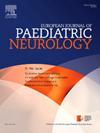Atypical neuroaxonal dystrophy in childhood related to PLA2G6: a French cohort
IF 2.3
3区 医学
Q3 CLINICAL NEUROLOGY
引用次数: 0
Abstract
Atypical neuroaxonal dystrophy (ANAD) is a rare form of neurodegeneration linked to the PLA2G6 gene. Unlike classical infantile neuroaxonal dystrophy (INAD), it occurs later in childhood and seems less progressive. It appears phenotypically different from juvenile form of Parkinson disease linked to PLA2G6 (PARK14). A genotype-phenotype correlation has been suggested.
We describe a large genetically confirmed cohort of pediatric patients with ANAD, describe their clinical symptomatology, brain imaging, other complementary explorations, symptomatic medication and compare to patients reported in the literature.
Fourteen patients were identified with early childhood onset and slowly progressive cerebello-spastic syndrome with variable dystonia and parkinsonism. Complementary investigations were inconsistently abnormal compared to INAD, with variable iron deposits on brain imaging, infrequent rapid rhythms on EEG and absence of neuronal spheroids on skin biopsy leading to diagnosis difficulties in absence of large molecular analysis. Nine of the seventeen reported variants were novel variants and a relative genotype-phenotype correlation was confirmed.
This study reports a large cohort of ANAD, providing new insights into this paediatric phenotype; which is less frequently described in the literature compared to INAD or PARK14.
与PLA2G6相关的儿童非典型神经轴突营养不良:一项法国队列研究
非典型神经轴突营养不良(ANAD)是一种罕见的与PLA2G6基因相关的神经退行性疾病。与典型的婴儿神经轴突营养不良(INAD)不同,它发生在儿童期较晚,似乎进展较慢。它在表型上不同于与PLA2G6 (PARK14)相关的少年型帕金森病。基因型与表型之间存在相关性。我们描述了一个大的遗传证实的儿童ANAD患者队列,描述了他们的临床症状,脑成像,其他补充探索,对症用药,并与文献报道的患者进行比较。14例患者被确定为儿童早期发病和缓慢进行性小脑痉挛综合征伴可变张力障碍和帕金森病。与INAD相比,补充检查不一致异常,脑成像上有不同的铁沉积,脑电图上有罕见的快速节律,皮肤活检上没有神经元球体,导致缺乏大分子分析的诊断困难。17个报告的变异中有9个是新变异,并且证实了相对的基因型-表型相关性。本研究报告了大量的ANAD队列,为这种儿科表型提供了新的见解;与INAD或PARK14相比,这在文献中较少被描述。
本文章由计算机程序翻译,如有差异,请以英文原文为准。
求助全文
约1分钟内获得全文
求助全文
来源期刊
CiteScore
6.30
自引率
3.20%
发文量
115
审稿时长
81 days
期刊介绍:
The European Journal of Paediatric Neurology is the Official Journal of the European Paediatric Neurology Society, successor to the long-established European Federation of Child Neurology Societies.
Under the guidance of a prestigious International editorial board, this multi-disciplinary journal publishes exciting clinical and experimental research in this rapidly expanding field. High quality papers written by leading experts encompass all the major diseases including epilepsy, movement disorders, neuromuscular disorders, neurodegenerative disorders and intellectual disability.
Other exciting highlights include articles on brain imaging and neonatal neurology, and the publication of regularly updated tables relating to the main groups of disorders.

 求助内容:
求助内容: 应助结果提醒方式:
应助结果提醒方式:


